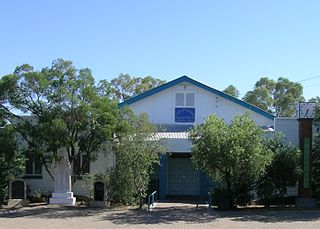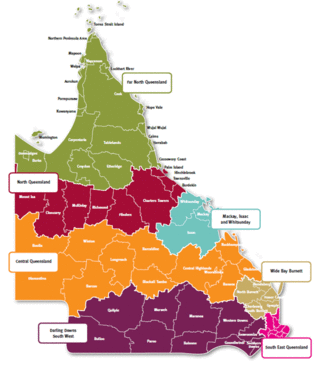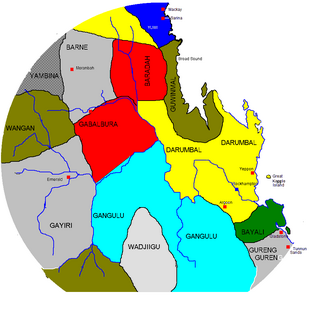
Blackdown Tableland is a national park in the Central Highlands Region, Queensland, Australia.

Augathella is a rural town and locality in the Shire of Murweh, Queensland, Australia. In the 2021 census, the locality of Augathella had a population of 328 people.

Central Queensland is an imprecisely-defined geographical division of Queensland that centres on the eastern coast, around the Tropic of Capricorn. Its major regional centre is Rockhampton. The region extends from the Capricorn Coast west to the Central Highlands at Emerald, north to the Mackay Regional Council southern boundary, and south to Gladstone. The region is also known as Capricornia. It is one of Australia's main coal exporting regions.

Woorabinda is a rural town and locality in the Aboriginal Shire of Woorabinda, Queensland, Australia. It is an Aboriginal community. In the 2021 census, the locality of Woorabinda had a population of 1,019 people with 91.6% identifying as Aboriginal or Torres Strait Islander.

Yarli (Yardli) was a dialect cluster of Australian Aboriginal languages spoken in northwestern New South Wales and into Northeastern South Australia individually Malyangapa (Maljangapa), Yardliyawara, and Wadikali. Bowern (2002) notes Karenggapa as part of the area, but there is little data.

The Gangulu people, also written Kangulu, Kaangooloo, Ghungalu and other variations, are an Aboriginal Australian people from the Mount Morgan area in Queensland, Australia.

The Yukulta language, also spelt Yugulda, Yokula, Yukala, Jugula, and Jakula, and also known as Ganggalidda, is a Tangkic language spoken in Queensland and Northern Territory, Australia. It was spoken by the Yukulta people, whose traditional lands lie on the southern coast of the Gulf of Carpentaria.

Maran or Maric is an extinct branch of the Pama–Nyungan family of Australian languages formerly spoken throughout much of Queensland by many of the Murri peoples. The well attested Maric languages are clearly related; however, many languages of the area became extinct before much could be documented of them, and their classification is uncertain. The clear Maric languages are:
Gurdjar (Kurtjar) is a Paman language of the Cape York Peninsula, Queensland, Australia. There are two dialects, Gurdjar proper, and Rip. According to the UNESCO Atlas of the World's Languages in Danger, the language is classified as extinct.
Mbara, and Yanga are mutually intelligible but separate Aboriginal language of Queensland, both now extinct. Glottolog assigns a code to a group level as Mbara-Yanga (mbar1254). Yanga is not to be confused with the Yangga language, a dialect of Biri.
Wanggamala, also spelt Wanggamanha, Wangkamahdla, Wangkamadla, Wangkamanha, Wangkamana, Wonkamala, Wongkamala, Wonkamudla, and other variants, is an extinct Australian Aboriginal language of the Pama–Nyungan family, previously spoken in the Northern Territory around Hay River and to the south of the Andegerebinha-speaking area.
Biri, also known as Biria, Birri Gubba, Birigaba, Wiri, Perembba and other variants, is an Australian Aboriginal language of the Mackay area of Queensland spoken by the Birri Gubba people. There are at least eight languages regarded as dialects of Biri, and two which are related but whose status is not yet fully determined. All are covered in this article.

Wamin, also known as Agwamin or Ewamian, is an Australian Aboriginal language of North Queensland spoken by the Ewamian people. Wamin was traditionally spoken in the Etheridge region, in the areas around Einasliegh, Georgetown, and Mount Surprise.
Ngadjunmaya correctly known as Ngadjumaya is a Pama–Nyungan language of Western Australia that is located in the Goldfields-Esperance region.
Yanda is an extinct and nearly unattested Australian Aboriginal language of Queensland. It was apparently close to Guwa.
Kungkari is an extinct and unclassified Australian Aboriginal language. The Kungkari language region included the landscape within the local government boundaries of the Longreach Shire Council and Blackall-Tambo Shire Council.

The Wadjiga people, also known as Wadja, Maudalgo, Wadjainggo, and other variants, were an Aboriginal Australian people of inland eastern Queensland.
The Bidjara or Pitjara are an Aboriginal Australian people of eastern Queensland. They are to be distinguished from the Bidjara of southwestern Queensland and the Badjiri of southern Queensland.
The Wakaman people, also spelt Wagaman, are an Aboriginal Australian people of the state of Queensland. According to some authorities, they may be interchangeable with the group identified by ethnographers as the Agwamin.
The Yagalingu are an Aboriginal Australian people of the state of Queensland. Their language may have been a dialect of Bidjara.









